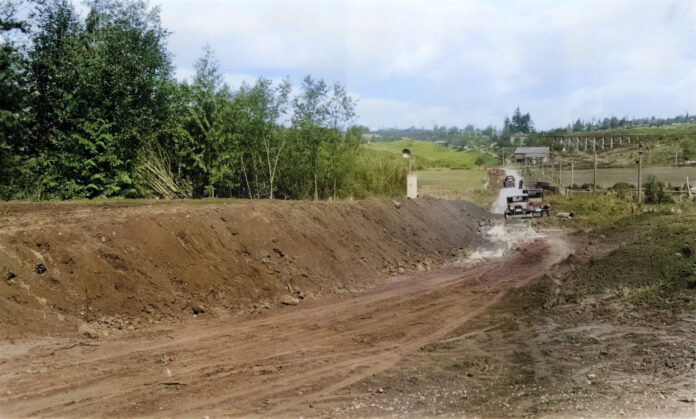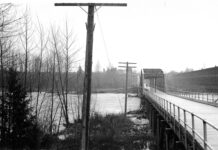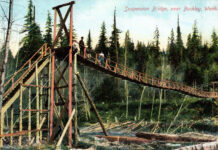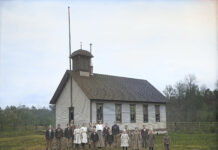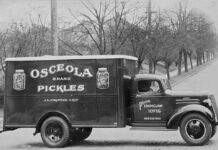When this colorized photo was taken in June 1932, there were two circuitous ways to travel between Black Diamond and Enumclaw. Each involved crossing the Green River. One route crossed the Whitney Bridge and climbed up the Enumclaw Plateau to dairy farms that dominated the landscape. The other course traveled east past the abandoned town of Franklin, passing over the Green River Gorge Bridge, then headed south along the Enumclaw-Franklin Road.
Fifteen months later a new road, called the Kummer Cut-off provided a direct connection and became King County’s highest bridge. It stretched over two football fields long and crossed steep canyon walls as it towered 15 stories above the rushing waters of the Green River. The Kummer Bridge on State Route 169 cut the travel distance by four miles. Today it sees typical daily traffic volumes of 10,000 to 15,000 vehicles. During the 1932-33 construction of the Kummer Bridge, Thomas Blum, a licensed surveyor who also served as King County’s bridge inspector, periodically snapped photos to document construction of the new route.
This picture looking north along Highway 169 was taken where vehicles first enter Black Diamond, when coming from the south. The view is just before passing Jones Lake. In the upper right-hand corner, just below the skyline was the Old Lawson railroad trestle that connected the coal mining towns of Black Diamond and Franklin. The branch rail line was abandoned two years later in 1934. The grassy fields on either side of the road have been owned by the Banchero family since the early 1920s.
The John Ottesen Construction Co. of Seattle was awarded a $37,000 contract to build the two-mile section of road between Black Diamond and the future bridge. The Union Bridge Company of Portland won the $95,500 contract to erect a 688-foot-long cantilevered design comprised of steel trusses held aloft by support towers resting on enormous concrete foundations.
Though King County funded this section of the road and bridge, the entire route’s 25-mile length from Enumclaw to Renton was incorporated into Washington’s transportation network in 1937 as Primary State Highway No. 5. It was renamed State Route 169 in 1964. However, between Nov. 2008 and June 2009, the Kummer Bridge was closed during an emergency reconstruction project after the discovery of major ground movements on the Enumclaw side. The $10 million project included a new retaining wall and was financed with funds from the federal government.
Officially the bridge is called the Dan Evans / Green River Bridge. But its common name, Kummer came from a small clay mining that was founded by the Puget Sound Fire Clay Co., and absorbed by the Denny-Renton Clay & Coal Co. around 1892. George W. Kummer was their ceramist, engineer, and one of the first to realize the site’s potential. Mr. Kummer later became the company’s sales manager. In later years coal was mined in and around Kummer with some of the production burned on-site to fire the clay.

